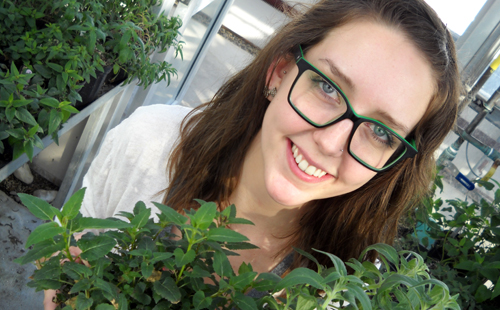
You might not be thinking about your garden just yet, but Emily Moeller is. How to make desired ornamental plants in less time is the topic of her master’s project in the Department of Plant Agriculture.
Using the tools of genetics and a longtime love of gardening, she aims to produce landscape plants that might use fewer nutrients and water or make more essential oils – all in less time than normal. That holds out possibilities for home gardeners and for growers supplying that market.
She’s relying on a trick practised by many plants called polyploidy. Unlike most animals, plants can still be coaxed to double their number of chromosomes – or even triple or quadruple them.
Biologists piggyback on a natural process in tinkering with chromosome numbers. Moeller says scientists think plants have undergone chromosome doubling many times during their evolution, using certain genes needed for survival and silencing or getting rid of others.
She works with two kinds of Monarda familiar to perennial gardeners: bee balm (Monarda punctata) and bergamot (M. fistulosa). Members of the mint family, both fragrant species contain essential oils that lend them medicinal properties when taken in tea, for example.
Encourage the plants to double their chromosomes, and you can often push them to do the botanical equivalent of Superman’s “faster, higher, stronger” mantra. Their leaves grow bigger. The plant becomes more drought-tolerant and makes more of those essential oils.
Moeller says researchers are studying how to push these individual traits, but her study is the first to connect all three characteristics in Monarda especially. It’s also the first to use a specific balance of regulatory hormones to allow for in vitro growing.
She had hoped to find a plant species with a ready-made tissue culture system, but couldn’t find one for a native plant making essential oils.
So she experimented to come up with her own system for Monarda involving a mix of plant hormones and two specific chemicals that induce chromosome doubling.
By early March, she had set stem fragments into the growth medium to produce new plants. In April, she will assess the plants for chromosome number and cell density. She will also measure stomata, or pores on the back of the leaves for air intake; pore size is connected to polyploidy.
She plans to grow the plants in campus greenhouses to see how they fare and to assess those favoured characteristics.
The landscape trades, such as commercial greenhouses and nurseries, want reliable plants with desirable traits that will grow quickly. An in vitro system allows the grower to start many more cuttings from a single “mother plant” than potting.
Not only that, she says, but “every plant comes out identical, which is what growers are looking for.”
That’s what home gardeners are seeking, too – including her mother, whose backyard in Dundas, Ont., is one large perennial garden. That’s where Moeller honed her own cultivating skills, working with everything from lilies to hostas.
She started her undergrad at Guelph in general biology but switched to botany in her second year. For her undergrad thesis for plant agriculture professor Al Sullivan, she looked at how chemicals cause genetic mutations leading to traits such as variegated leaves desired by gardeners. She’s still working with Sullivan on her graduate degree.
“Emily’s research is part of a larger program to develop new varieties of plants that are adapted to environments with low water and nutrient availability,” he says. “Native species have been our main focus because many already are adapted to the harsher environments of the natural landscape.”
Emily’s take on working with plants?
“They’re so cool, are you kidding me?” she says. “Cut them up and they grow clones. Double the chromosome numbers, and they keep going.”
She had thought about becoming a nurse but prefers to keep working with ornamentals after graduating this year. Unlike human patients, she says, plants “don’t complain when you cut them.”
Producing lots of native plants with certain characteristics in a rapid and reliable way might interest landscapers in municipalities such as Toronto, she says. There, a “green standard” bylaw passed in 2012 requires landscaping for all development to contain half native species and half drought-tolerant species.